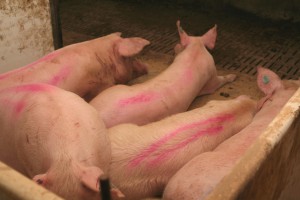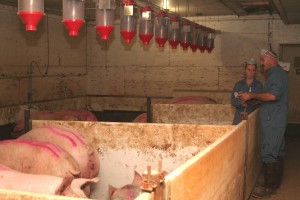 Complete remodelling of 600-sow farrow to finish barns into 1800-sow units producing isowean pigs is the route to expanding the sow base at Humboldt, Sask. based Big Sky Farms, which currently has 49,000 sows. And, says production manager Richard Johnson, it will cut overhead costs per sow leading to a lower cost per piglet produced. The company purchased the assets of Community Pork Ventures (CPV) in 2005, a production system that had been based on 600-sow farrow to finish barns, with four units in the 12,000 sow operation holding 1200 sows. However, the Big Sky production model was based on three-site production, with large-scale breeding units, off-site nurseries and contract finishing barns. “As we got to know and work with the CPV system, we thought there was an opportunity to expand and/or retrofit the systems, which in turn would give us a greater return on capital invested,” explains Johnson. “Not only can we spread our central overhead and management costs over more sows but the specialization in just breeding and farrowing leads to better results.”
Complete remodelling of 600-sow farrow to finish barns into 1800-sow units producing isowean pigs is the route to expanding the sow base at Humboldt, Sask. based Big Sky Farms, which currently has 49,000 sows. And, says production manager Richard Johnson, it will cut overhead costs per sow leading to a lower cost per piglet produced. The company purchased the assets of Community Pork Ventures (CPV) in 2005, a production system that had been based on 600-sow farrow to finish barns, with four units in the 12,000 sow operation holding 1200 sows. However, the Big Sky production model was based on three-site production, with large-scale breeding units, off-site nurseries and contract finishing barns. “As we got to know and work with the CPV system, we thought there was an opportunity to expand and/or retrofit the systems, which in turn would give us a greater return on capital invested,” explains Johnson. “Not only can we spread our central overhead and management costs over more sows but the specialization in just breeding and farrowing leads to better results.”
The first unit to undergo the transformation was the company’s Kelsey barn, located near Melfort, Sask. Additional sow pens were made by modifying the existing part slatted finishing rooms, which had pens of 23 pigs. Three pens were made into one, although the pen divisions between the lying areas were left in place. Each pen now holds 30 sows, which are fed on the floor using volumetric drop dispensers. One of the finisher rooms was left with 12 small pens in order to house sick, lame or thin sows, something Johnson knew was essential in a floor-fed system from his previous experience with group housing in the UK. In addition, two of the grower rooms were also converted to sows pens, giving a total capacity for 1120 sows from 30 days into gestation up to removal for farrowing. The remaining 6 grower rooms were used to construct a further 240 farrowing pens, while the original nursery rooms hold piglets ready for shipping. From weaning until 30 days, sows are housed in stalls in the existing breeding and gestation areas.
 Experience with the group sow pens has been generally positive, but not without its teething problems, says unit manager Susan Armstrong. “Our biggest problem has been variation in the weight of feed dispensed, which has ranged from 7-12 lb per drop, making it difficult to feed accurately.” Gilts are penned separately and sows are grouped by body condition in order to feed more accurately, something that’s necessary when floor feeding. However, that makes it more difficult to remove sows for farrowing, says Armstrong. “We can’t remove all the sows at one time as we would if they were grouped strictly by breeding date,” she explains. Also, sow behaviour is rather aggressive with floor feeding, although no vulva biting has been noted so far. Scanning sows in the group has proved more difficult than when sows are in stalls. “We carry out the first scan when sows are in stalls in the implantation area, but we also like to do a second confirmation of pregnancy at 65 days,” Armstrong says.
Experience with the group sow pens has been generally positive, but not without its teething problems, says unit manager Susan Armstrong. “Our biggest problem has been variation in the weight of feed dispensed, which has ranged from 7-12 lb per drop, making it difficult to feed accurately.” Gilts are penned separately and sows are grouped by body condition in order to feed more accurately, something that’s necessary when floor feeding. However, that makes it more difficult to remove sows for farrowing, says Armstrong. “We can’t remove all the sows at one time as we would if they were grouped strictly by breeding date,” she explains. Also, sow behaviour is rather aggressive with floor feeding, although no vulva biting has been noted so far. Scanning sows in the group has proved more difficult than when sows are in stalls. “We carry out the first scan when sows are in stalls in the implantation area, but we also like to do a second confirmation of pregnancy at 65 days,” Armstrong says.
Farrowing the target of 85 sows per week started at the beginning of December and the goal is to wean 900 pigs per week at an age of 20-21 days. These are shipped to the USA with another 900 pigs from another barn to make up a full load of 1800. Big Sky has a contract in place for these pigs to be raised in wean-to-finish barns in Iowa, managed by South Central Management Services, but they retain ownership. Finished pigs will be marketed in the US Mid-West but, initially at least, not tied to a specific packer.
While the decision at the time was to finish pigs in the USA, they could just as easily be reared in low-cost contract finishing barns in Saskatchewan, says Richard Johnson. “It’s currently a lot more attractive to finish in the US, but that could change.” The main motivation for the unit remodelling was to improve return on capital, he stresses. “We will make more money doing this than operating a farrow to finish operation. We modelled a range of different scenarios for these barns with a range of feed prices and in every case the farrow to isowean option was the most profitable.”
Big Sky plans to convert more of the ex-CPV units, drawing on the experience of this first one, especially how the group housing works. “It may prove best to remove the partial pen divisions in the group pens, to allow for sows to move around freely while feeding.” Johnson feels. “Also, we may need to fine-tune space allowances and how we group sows according to age and condition.” So far, though, performance has been up to expectations, with the mainly gilt herd farrowing 11.9 born alive per litter.
In time, converting all the ten 600-sow barns would allow an increase in the company’s sow base of 12,000, but Johnson says that’s a long-term goal. “We do want to expand in order to reduce cost,” he says. “Also, having a lot of sows in group housing will give us additional marketing opportunities and could allow us to develop added value pork products.”
Photo captions:
- New_Sow_pens-1.jpg: Richard Johnson discusses the group sow pens with unit manager Susan Armstrong
2. Sows in group pens-1.jpg: Sows lie quietly in the converted finishing pens









